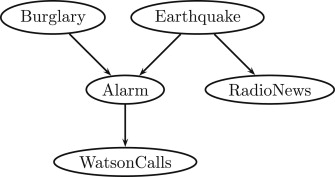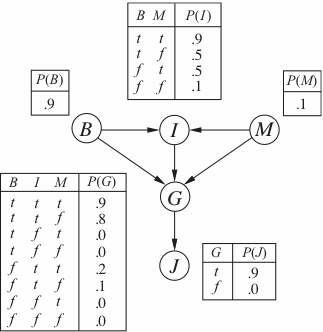
Due Date: Due June 4, 11:59pm in dropbox. |
A. [5pts] Model this employment process as a Markov chain.
B. [5pts] If you start out employed, what is the probability of being employed at step three? Show all of your work.
C. [5pts] If you are unemployed at time 3, what is the probability that you started out employed at time 1
D. [5pts] What is the stationary distribution of the chain you defined?
A. [14pts] Model this problem as a Bayesian network representing a joint distribution over four binary random variables. Since there is more than one possible answer, briefly motivate your choices.
B. [6pts] Write three independence assumptions that your network encodes.

Consider the above Bayes net.
The variables are boolean and describe aspects of a court trail. They indicate whether someone broke an election law (B), was indicted (I), whether the prosecutor was politically motivated (M), if the person was found guilty (G), and if they were ultimately put in jail (J).
A. [9pts] Which of the following are true:
C. [3pts] What is P(j,i,g | ¬m)?
A. [5pts] What is the probability that a message contains the word "Pills" and is Spam?
B. [5pts] What is the probability that a message is Spam if it is known to contain the word "Pills"?
C. [5pts] What is the probability that a message does not contain the word "Pills" or is Spam?

Consider computing the query P(B|W=true)
A. [7pt] Write the set of initial factors that would be created, after incorporating evidence. You do not need to write the full tables of numbers for each factor, just clearly indicate the function signature, e.g. P(X,Y,Z).
B. [10pt] Write, in order, the signatures for the new factors that get created when running the variable elimination algorithm with the variable elimination ordering A, E, R.
C. [7pt] Provide, if possible, a variable ordering that is more comptuationally efficient than the one in part B.
D. [6pt] Provide, if possible, a variable ordering that is less comptuationally efficient than the one in part B.